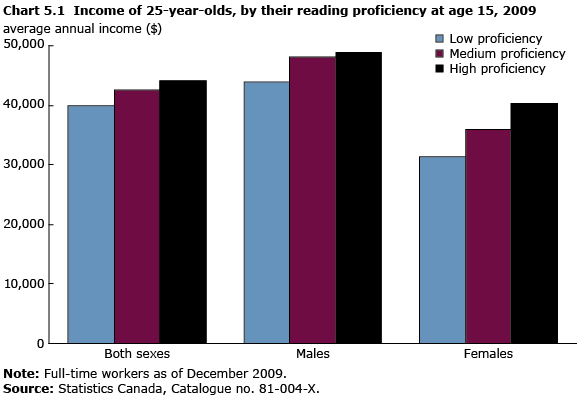Children and youth
Archived Content
Information identified as archived is provided for reference, research or recordkeeping purposes. It is not subject to the Government of Canada Web Standards and has not been altered or updated since it was archived. Please "contact us" to request a format other than those available.
Related information
Young people with higher proficiency in reading at age 15 have higher educational attainment and income by the time they are 25 than those with lower proficiency in reading at age 15.
Among 15-year-olds identified in 2000 with a high level of reading proficiency, 3 out of 4 had completed some form of postsecondary education by age 25. By the same age, over half (54%) of 15-year-olds with a low level of reading proficiency had not completed any education beyond high school.
Reading skills and educational attainment
Reading scores at age 15 were linked to the type of postsecondary education completed by age 25. By 2009, youth with low scores were over three times more likely to have completed college (or CEGEP in Quebec) than a university degree (29% versus 9%). Of youth with mid-range scores, 30% had completed college and 24% had ended university studies with an undergraduate degree or less.
Youth with high scores had even higher rates of university completion: nearly half (46%) had ended university studies with an undergraduate degree or less and 7% had completed studies above the bachelor's level; 21% had completed a college education.
Educational attainment varied not only by reading proficiency level at age 15, but along gender lines as well. More than half (57%) of the boys who had below-average reading proficiency stopped their education at the high-school level; a smaller proportion of similarly-scoring girls did so (49%).
Of youth who had mid-range scores, 45% of boys ended their education at the high-school level, compared with 33% of girls. Meanwhile, boys who had high scores were over one-and-a-half times more likely than high-scoring girls to not pursue postsecondary education (29% versus 18%).
Irrespective of reading proficiency at age 15, most young people (61%) made the transition to full-time work by the age of 25. But among those who did not, important life-path differences were associated with reading proficiency at age 15.
Young people who had a high score for reading proficiency at age 15 in 2000 were more than twice as likely as those who scored lowest to still be in school a decade later (26% versus 12%). Meanwhile, 15% of those who scored the lowest for reading proficiency at age 15 were neither in school nor working at age 25. This was a rate nearly twice that of their peers who had scored highest (8%).
Reading skills linked to future income
The income of 25-year-olds varied according to their reading proficiency scores at age 15. In 2009, the 25-year-olds who scored the lowest at age 15 had an average annual income of $39,902. This rose to $42,580 for those with mid-range scores and to $44,155 for those with the highest scores. The income difference between those with the lowest and highest scores was about 10%, or $4,000 annually—this difference was wider for women than men.
While low scorers at age 15 had a longer period of work experience by age 25, the income differences suggest that earlier entry into the labour force does not compensate for the financial benefits of completing higher levels of education.
Reading skills, marriage and parenthood
In 2009, about one-third of 25-year-olds—about 30% of males and 45% of females—were married or living in a common-law relationship. There was little difference in this characteristic across reading proficiency levels. For both genders, the difference between low scorers at age 15 and high scorers was about 5 percentage points.
By contrast, large differences—both between genders and across proficiency levels—were seen in the proportion of the 25-year-old population who had children. Overall, 15% of the 25-year-olds had children; by gender, 9% of the men had children and 20% of the women did.
For each gender, those with low reading proficiency scores at age 15 were more than twice as likely as those with high scores to have children by age 25. Of the 15-year-old boys with low scores in 2000, 13% had children by age 25 in 2009, compared with 6% of the boys who had high scores. For the girls, the respective figures were 32% compared with 14%, a difference of 18 percentage points. This suggests that girls with high reading proficiency at age 15—the group most likely to pursue postsecondary studies—are also the least likely women to have children by age 25.
- Date modified:

